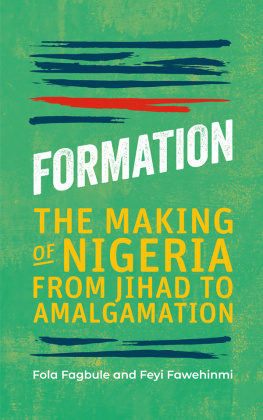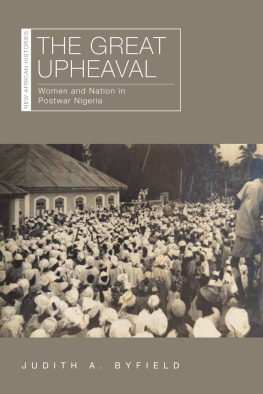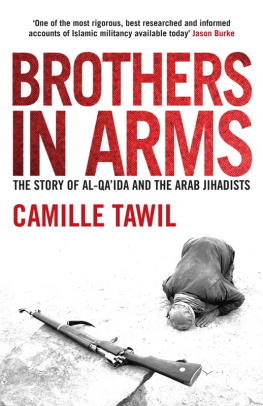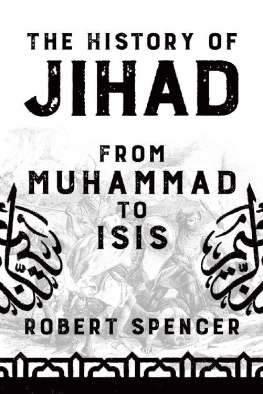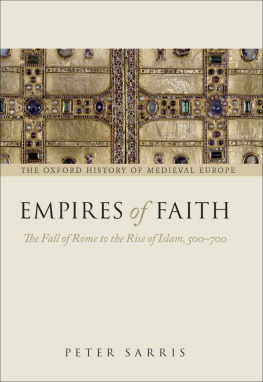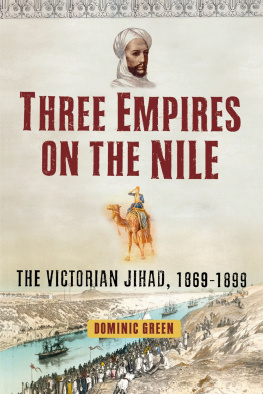FORMATION
The Making of Nigeria from
Jihad to Amalgamation
FORMATION
The Making of Nigeria from
Jihad to Amalgamation
FOLA FAGBULE
FEYI FAWEHINMI

First published in Nigeria 2020 by Cassava Republic Press Abuja London
First published in the UK & USA in 2021 by Cassava Republic Press
Copyright Fola Fagbule and Feyi Fawehinmi
All rights reserved. No part of this book may be reproduced, stored in a retrieval system, or transported in any form or by any means (electronic, mechanical, photocopying, recording or otherwise), without the prior written permission of the publisher of this book.
The moral right of Fola Fagbule and Feyi Fawehinmi to be identified as the Authors of this work has been asserted by them in accordance with the Copyright, Designs and Patents Act 1988.
A CIP catalogue record for this book is available from the National Library of Nigeria and the British Library.
ISBN 978-1-913175-09-2
eISBN 978-1-913175-10-8
Editor: Bibi Bakare-Yusuf
Copy editor: Layla Mohamed
Proofreader: Uthman Adejumo
Book design by Adekunle Adebisi
Cover & Art Direction by Wilna Combrinck
Printed and bound in the UK
Distributed in Nigeria by Yellow Danfo
Distributed in the UK by Ingram
Worldwide distribution by Ingram Publisher Services International
Stay up to date with the latest books, special offers and exclusive content with our monthly newsletter. Sign up on our website:
www.cassavarepublic.biz
Twitter: @cassavarepublic
Instagram: @cassavarepublicpress
Facebook: facebook.com/CassavaRepublic
Hashtag: #FormationNG #ReadCassava
CONTENTS
INTRODUCTION
How Did We Get in Formation?
Nigeria is the largest Black country in the world. Formed around two mighty rivers and made up of a stunning diversity of peoples and lands, there is no shortage of stories about the history, politics and culture of Africas most populous nation. But how did the country come to be in the first place? A combination of factors has ensured that this is not as easy a question to answer as it should be.
Many official versions of Nigerias creation story do exist. Yet, as with all official histories, these stories are often coloured by the lenses of politics and agenda worn by the narrators. This has not always been for lack of carefully preserved records and credible eye-witness accounts, certainly not in the one-hundred-year period immediately preceding formation. Nor has it always been on account of a dearth of rigorous academic work by indigenous and foreign historians. A lot of great history books and research studies have been written about Nigeria. It has not even been so much the result of popular disinterest in the subject. Quite the contrary, Nigerians are as passionate about their history as any people anywhere in the world. We might never all agree on what version of history is the correct one, but we share an abiding interest in the subject.
So how did Nigeria come to be in the first place? And why is there not a deliberately apolitical, nuanced and coherent origin story available for our modern generation to grapple with? Our objective with Formation: The Making of Nigeria from Jihad to Amalgamation is to answer the former question, and in doing so occupy the vacuum described by the latter. Formation is a work of popular history. Neither of us have been trained as historians; we both work in financial services. But we share a belief that history is too important to be left to historians alone. We also believe that a story this fascinating only needs careful narrators for it to shine on its own merits. So, this is how we got into Formation.
Formation is our brick for the construction of the common house that is Nigerias origin story.
Our narrative begins with a description of the great, muddy, contorted water bodies that we consider to be the raison detre for Nigeria in the first place: The River Niger and its sister, the Benue. In A River Runs Through It, we trace the history of the Niger, which is the central setting for much of the events retold in the rest of our narrative. We also explain why the rivers are so important to the structure of the country, and we introduce our ideas as to how these mighty water bodies served at once to attract and divide the humans of Nigeria. We also describe some critical adjacent river roads, which combine with the great rivers to complete the tapestry into which our narrative is intricately woven.
Next, our story properly begins with a stunning revolution at a place called Gobir. This successful revolution and its unlikely leader, known as the Son of the Jurist would turn out to be the landmark event that fired the starting gun on the series of actions leading to Formation. We proceed to assess the resulting Caliphate in Session following the Gobir revolt, and very early in our narrative begin to chronicle some of the successes and failures that would come to define the character of Nigeria to the present day. From here, the pace of our story quickens considerably because we have to catch the Oyo Empire at its dramatic moment of disintegration, triggering a devastating civil war from which a group of hardy survivors would emerge at a settlement called Abeokuta, the ray of Sunrise within the Tropics. The remarkably astute geopolitical and foreign policy posturing of this small settlement and its accomplished civil and military leaders would prove to be our second most important milestone, crystallising another series of events leading to Formation.
From Abeokuta, our story takes on an even more multinational colour, as the foreign adventurers whom we term Mad Men and Missionaries arrive on the scene with their unique agenda. We describe their agenda in detail and retell the story of their successes and failures, which will also come to greatly shape the character of the future country, Nigeria. A few short decades later, our tale of Formation becomes even more complex. As we show in Exit the Bible, Enter the Gun, the global Industrial Revolution, which began in the eighteenth century in Britain, arrived on the scene in pre-colonial Nigeria with force and determination. Next to the Gobir revolution and the clever survival strategies at Abeokuta, the Industrial Revolution would prove to be the third most significant event, triggering another series of actions leading to Formation. We show how the Industrial Revolution led to a shift in the terms of export trade from stolen human bodies to palm oil and other commodities, dramatically altering the state of affairs in the still inchoate country.
With this change, the arrival of The Glorious Incompetents on the scene was portentous for the future country, which was to be forcibly formed from a combination of imperial vision and capitalist zeal. We chronicle some of the more destructive consequences of this irresistible combination for the existing indigenous ruling classes. We continue with this theme in Game of Thrones in the Niger Heartland, retelling the story of what happened when an unstoppable force met with an immovable object.
Finally, with the benefit of all the preceding colourful background stories, we can arrive at the more popular modules of Nigerias pre-colonial history. The detestable as well as remarkable actions of Frederick Lugard, The King in the North can now be understood in their proper context, challenging the outsized significance that has been placed on them in the official versions of Nigerias history. With proper context, we demonstrate how Lugards revolution was in many ways the completion and expansion of the work started by the Son of the Jurist. With nuance and balance, we illuminate the brief period of Conquest and Discontent which followed the emergence of Lugard on the scene.
Next page
